Capital of the Philippines
 |
| This article is part of a series on the politics and government of the Philippines |
|
Legislature
|
|
Constitutional Commissions |
This is a list of current and former national capital cities in the Philippines, which includes during the time of the Spanish colonization, the First Philippine Republic, the Commonwealth of the Philippines, the Second Republic of the Philippines (Japanese-Sponsored Republic), the Third Republic of the Philippines, the Fourth Republic of the Philippines and the current Fifth Republic of the Philippines.[1]
The current capital city, Manila, was established by presidential order on June 24, 1976.
History
On April 7, 1521 Ferdinand Magellan landed in Cebu. He was welcomed by Rajah Humabon, who, together with his wife and about 800 natives, were baptized by the Spaniards on April 14, 1521 and are considered to be the first Filipino Catholics. Magellan, however, failed to successfully claim the Philippines for the crown of Spain, having been slain in neighboring Mactan Island .
A Spanish expedition ordered by the conquistador Miguel López de Legazpi demanded the conquest of Manila. His second on command, Martín de Goiti departed from Cebu and arrived in Manila. The Muslim Tagalogs welcomed the foreigners, but Goiti had other plans. The Spanish force of 300 soldiers marched through Manila and a battle was fought with the heavily armed Spaniards quickly defeating and crushing the native settlements to the ground. Legazpi and his men followed the next year and made a peace pact with the three rajahs and organized a city council consisting of two mayors, 12 councilors, and a secretary.
A walled city known as Intramuros, at the southern banks of Pasig River was built to protect the Spanish colonizers. On June 10, 1574, King Philip II of Spain gave Manila the title of Insigne y Siempre Leal Ciudad ("Distinguished and Ever Loyal City"). In 1595, Manila was proclaimed as the capital of the Philippine Islands and became a center of the trans-Pacific silver trade for more than three centuries.
When the British capture Manila from Spain, they transfer the capital to Bacolor, Pampanga, however the capital move back to Manila after the two colonizers sign the 1763 Treaty of Paris.
When Philippine Revolution exploited in 1896, The town of Malolos in the northern province of Bulacan became the headquarters of the revolutionary movement yet several other towns became capitals, at a succeeding rate to avoid capture from the Americans during the Philippine–American War. The status of the national capital moved back to Manila after capture of President Emilio Aguinaldo on 1901.
1905 Burnham Plan of Manila
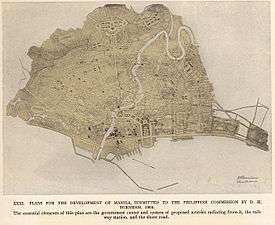
When the Americans came they decided that Intramuros was not big enough, nor appropriate for their new colony. They called in the famous architect and planner, Daniel Burnham, to design the new capital. This he did in grand fashion using Washington D.C. as a model. The national civic center was placed outside the old walls in the open field called Bagumbayan. Burnham planned a large capitol building surrounded by supporting government offices in a formal setting that was close to a mirror image of Washington’s. The National Mall is now our Luneta, or Rizal Park. Only the Agriculture and Finance Buildings were built of the original civic group. The National Library was also built in the 1920s but turned into the Legislative Building in lieu of the Capitol that could not get built because of budgetary cuts.
Burnham proposed a parkway along Manila bay extending from the Luneta southward all the way to Cavite. This was to be a 250’ wide boulevard – with roadways, tramways, bridle paths, rich plantations, and broad sidewalks and should be made available to all classes of people. Burnham further recommended – shaded drives along the Pasig all the way to Ft. McKinley, which we now know as Fort Bonifacio, and beyond as part of the park and parkway system. Burnham ended his report by the following words:
| “ | possessing the bay of Naples, the winding river of Paris, and the canals of Venice, Manila has before it an opportunity unique in the history of modern times, the opportunity to create a unified city equal to the greatest of the Western World with the unparalleled and priceless addition of a tropical setting ... | ” |
By 1928 a major revision of the plan was undertaken. A committee led by Manuel Mañosa, Sr. and Juan Arellano produced a Zoning Plan for Manila based on the original Burnham Plan. This was printed and distributed free to the public for feedback. The final drawings and documents were recommended for approval in 1933 and eventually became the basis for Manila's first zoning ordinances.
Burnham’s Manila plan was prepared for a city with a maximum population of 800,000 people. The population of the city of Manila was only 285,000 in 1918, but it grew at 5.6 percent per year to more than 600,000 in 1939. At that rate, Manila would have been filled to capacity.
But then in the 1930s just as the Commonwealth government had finally built the Burnham Plan's seaside drive – named Dewey Boulevard and now known to us as Roxas Boulevard – and finally finished the Post Office Building, the Finance and Agriculture Buildings, it decided to scrap the Burnham Plan and replace it with a new metropolis elsewhere. One of the main reasons given was that the proposed National Capitol to be built in the vicinity of the present-day Rizal Park was too susceptible to naval bombardment.
1941 Frost-Arellano Plan – Quezon City
During the time of the Commonwealth, Manila still served as the nation's capital. During these times too that Commonwealth President Manuel L. Quezon dreamed of a city that could become the future capital of the country, replacing Manila. In the summer of 1939 President Quezon contacted William Parsons and asked him to choose a new site for and then to design a new Philippine Capitol. Parsons arrived in June 1939 and eventually chose Diliman as the new capitol site. He also managed to produce a master plan for the new University of the Philippines. Unfortunately he died in December of that year. Harry Frost, Parsons’ former partner took over and joined Juan Arellano and A. D. Williams in the Planning Commission. A fourth member of the team, landscape architect Louis P. Croft joined them as advisor on planning and park design. They are commissioned to produce a master plan for Quezon City. It was approved in 1941.
The elliptical circle was the focal point of a grand quadrangle defined by the geographically named avenues and reached by a grand boulevard connecting it to the very center of old Manila via Quezon Bridge. The circle was to house the new legislative complex, a magnificent group of buildings with the halls of Senate and the House. On either side of North and East Avenues were to be the executive and judiciary complexes of the national government. All of these complexes were set in landscaped sites and surrounded by public parks and open spaces. The new National Capital City complex was thus defined with the three branches of government connected and framed by the Diliman Qaudrangle. eventually. The elliptical circle was turned to a memorial to Quezon. The 400 hectares of the Diliman quadrangle was allocated by the commission as the city's central park. This central park was to contain the national botanic garden, the national zoo, athletic grounds, a grand stadium and even a golf course. The park was to be the main component of a comprehensive city-wide park and parkway system. This system would have included another 80-hectare park in the north, various parks and greenbelts along creeks and rivers, numerous playgrounds and athletic fields. Finally, there was to be a major greenbelt all along the Marikina and San Mateo valley – to contain urban sprawl, preserve the agricultural land and protect the city’s watershed areas. None of the intended parks and parkway system was ever built.
During the Japanese-sponsored Second Philippine Republic and throughout World War II Manila still served as the nation's capital, However Baguio serve as the temporary capital of government in exile and the site where General Tomoyuki Yamashita and Vice Admiral Okochi surrendered.
Quezon died in exile during the war years. After the war, Quezon City was put back on track as capital of an independent republic. In 1945, President Sergio Osmeña, who had taken over when Quezon died, organized the Quezon Memorial Committee (QMC) to raise funds for a memorial.
In 1946 newly elected President Manuel Roxas created a Capital Site Committee to look at other possible sites. The old capitol site was not deemed defensible enough from military attack nor the area large enough to accommodate a projected population of several million people. Sixteen other sites were evaluated. The committee was formed to look at 16 other options to Novaliches. These included, among others: Tagaytay, Cebu, Davao, San Pablo, Baguio, Los Baños, Montalban, Antipolo, and Fort McKinley. The committee even considered moving the capital to Boracay Island but the raised elevation of Novaliches was finally chosen. The original Diliman area was thus enlarged to include the Novaliches watershed to the North all the way to Wack Wack in the south. In essence, the Frost Plan was revived under the National Planning Commission first headed by Croft then later by Harvard-trained Anselmo Alquinto. The plan was revised in 1947, 1949 and finally in 1956.
The civic center under these revisions was to be moved northeast from the elliptical circle to a 158 hectare area called Constitution Hill. The three branches of government and support offices were laid in a formal layout reminiscent of the UP plan. In the middle was to be a 20 hectare Plaza of the Republic. The whole complex was to be connected to Manila by an East-West parkway called Republic Avenue. That plan was submitted and approved by President Quirino in 1949 but it would take close to thirty years before the Batasan Pambansa was completed in 1978.
Transfer of Nation's Capital – Metro Manila
During President Ferdinand Marcos' period of Bagong Lipunan (New Society), Quezon City's stature of being the nation's capital was transferred to Manila and the area now known as Greater Manila Area (later, Metro Manila) on June 24, 1976 by Presidential Decree No. 940. President Marcos also considered an alternative site for the national capital. A joint study was conducted by the architecture and planning offices of Cesar Concio and Felipe Mendoza, comparing the original Novaliches site and a newly reclaimed stretch of land south of the new Cultural Center of the Philippines. but the Novaliches was still chosen for the proposed capital.
During the administration of Fidel V. Ramos there were suggestions during his term to move the nation's capital to Fort Bonifacio as part of the conversion plans then. While Gloria Macapagal Arroyo proposed that the nation's capital to move to Cebu City.
But the richest city in the country is now on the move to strip Manila of its status as the country’s capital city. In a resolution, a Quezon City councilor is urging Congress to enact a law, declaring it as the new capital of the Republic of the Philippines.[2]
Other capitals
Baguio was formerly designated as the "summer capital" of the country from 1903 to 1976. A presidential mansion is within the city limits, and the Supreme Court still holds their April–May summer sessions at Baguio. Presidential Decree No. 940 of 1976 made no mention of Baguio continuing to serve as the "summer capital", but the city still holds the distinction in an unofficial capacity.
List
| Location | Island Group | Since | Until | Description | |
|---|---|---|---|---|---|
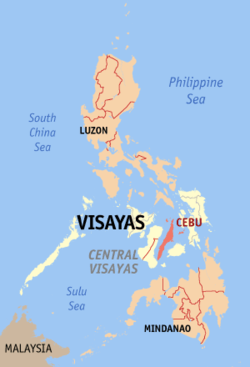 |
Cebu | Visayas | 1565 | 1569 | Miguel Lopez de Legaspi established its first Spanish settlement in the archipelago. |
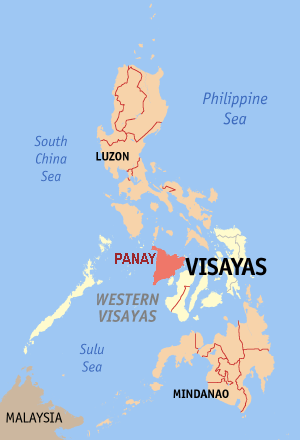 |
Iloilo (Panay island) | Visayas | 1566 | 1576 | Second settlement of Spaniard. Establish as capital before conquest of Manila. |
| |
Manila | Luzon | 1571 | 1941 | Served as the seat of Spanish colonial government in the Philippines |
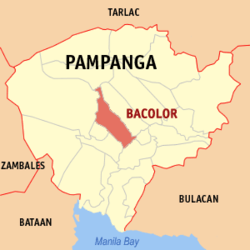 |
Bacolor, Pampanga | Luzon | 1762 | 1764 | Temporary headquarters of the Spanish colonial government during the British occupation of Manila. |
 |
San Miguel, Bulacan | Luzon | February 1897 | October 1897 | Served as the capital of short lived Republic of Biak-na-Bato |
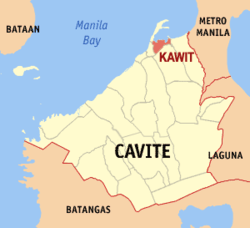 |
Cavite El Viejo | Luzon | 1896 | 1898 | Hometown of General Emilio Aguinaldo where independence was proclaimed during the Philippine Revolution. |
 |
Manila | Luzon | 1898 | 1941 | Served as the seat of government during the American military occupation, civilian insular government, and the Commonwealth until World War II. in 1901, the capital engulfed nearby municipalities like Ermita, Tondo, Santa Cruz, Santa Ana de Sapa, San Nicolas, San Miguel, San Fernando de Dilao, Port Area, Pandacan, Sampaloc, Quiapo, Binondo, Malate, San Andres, and Santa Mesa to form one city. The area in which Manila was used to be called before, was named Intramuros, also known as the "walled city". |
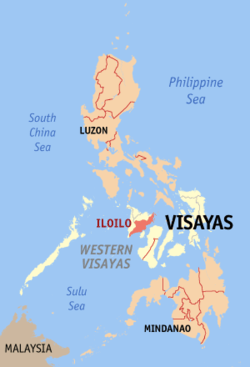 |
Iloilo, Panay Island | Visayas | November 17, 1896 | March 1939 | After the Fall of Manila, the Spanish Governor-General Diego de los Ríos tries to revive the colonial government in Iloilo until the Spanish forces surrendered to the Americans. It is the last seat of the Kingdom Of Spain in Asia until 1939. |
 |
Zamboanga | Mindanao | January 1898 | July 1898 | |
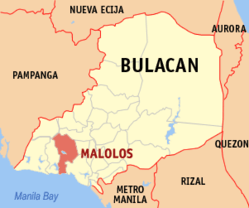 |
Malolos, Bulacan | Luzon | 1898 | 1899 | Served as the Official Capital of the Republican government during the Philippine–American War. |
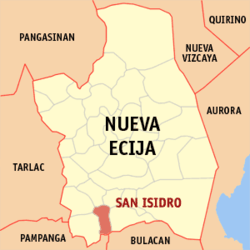 |
San Isidro, Nueva Ecija | Luzon | 1899 | 1899 | After the Americans besieged Malolos on March 31, 1899, Aguinaldo transferred his headquarters in several towns in attempt to escape from American forces and continue his revolution. |
 |
Angeles, Pampanga | ||||
 |
Cabanatuan, Nueva Ecija | ||||
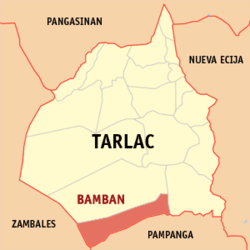 |
Bamban, Tarlac | ||||
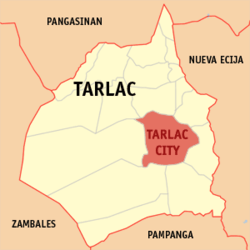 |
Tarlac City, Tarlac | ||||
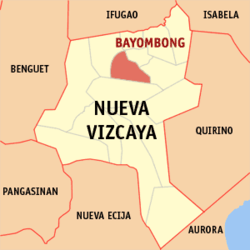 |
Bayombong, Nueva Vizcaya | ||||
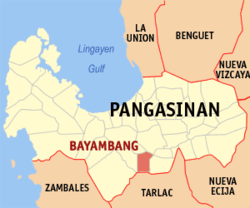 |
Bayambang, Pangasinan | ||||
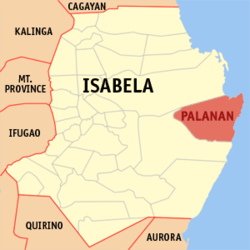 |
Palanan, Isabela | Luzon | 1900 | 1901 | Aguinaldo's last hideout until he was captured by the forces of Frederick Funston and surrendered to the Americans. |
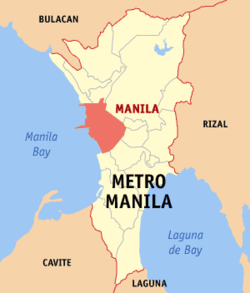 |
Manila | Luzon | 1941 | 1945 | Served as the seat of government of during the Japanese occupation and the Japanese-sponsored Second Republic of José P. Laurel. |
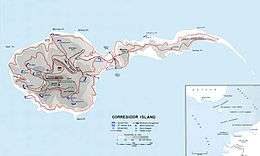 |
Corregidor Island | Luzon | 1941 | 1942 | Temporary headquarters of the Commonwealth government-in-exile led by President Manuel L. Quezon when Japanese forces invade Manila. |
 |
Washington D.C | United States | 1942 | 1944 | |
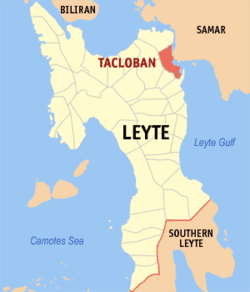 |
Tacloban | Eastern Visayas | 1944 | 1945 | Landing site of General Douglas MacArthur and the American forces during the end stages of World War II. Served as the temporary headquarters of the Commonwealth led by President Sergio Osmeña until liberation. |
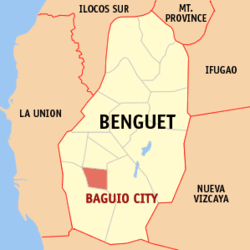 |
Baguio | Luzon | 1944 | 1945 | After the Battle of Manila, the headquarters of the Second Republic was moved to Baguio until Laurel announced its dissolution in Tokyo. |
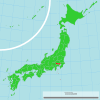 |
Nara/Tokyo | Japan | 1944 | 1945 | |
 |
Manila | Luzon | 1945 | 1948 | Became the capital of the Third Republic after the Second World War. |
 |
Quezon City | Luzon | 1948 | 1976 | By virtue of Republic Act No. 333 by Elpidio Quirino. |
 |
Manila | Luzon | 1976 | Present | Issued by Ferdinand Marcos on June 24, 1976 via Presidential Decree No. 940. Reorganized the capital and seat of government by incorporating |
Other former sovereign capitals
| Official Name | Present-day area | Since | Until | Description | |
|---|---|---|---|---|---|
| Bacolod | Republic of Negros | Negros | 1898 | 1901 | The city was declared the capital after the Negros Revolution. |
| Zamboanga City | Republic of Zamboanga | Zamboanga Peninsula | 1898 | 1901 | The area encompasses the whole Zamboanga Peninsula and claimed the whole Mindanao as its territory. |
| Astana Putih (currently Jolo) | Sultanate of Sulu | Sulu | 1405 | 1915 | The Sultanate of Sulu was independent until 1915. |
| Batan (currently Kalibo) | Confederation of Madya-as | Panay | 1200 | 1570 | The establishment of the Spanish settlement in Oton and conquest of Panay effectively extinguished the confederation. |
| Kuta Wato (currently Cotabato City) | Sultanate of Maguindanao | Maguindanao | 1500 | 1888 | The sultanate encompasses the current Cotabato Region and the Province of Maguindanao. |
| Tondo | Kingdom of Manila | Metropolitan Manila | 1500 | 1570 | The destruction of Fort Seludong and the establishment of Intramuros ended the rule of local Muslim rulers and ushered the Spanish era. |